Cairo Meaning In The Bible: History and Symbolism
Cairo, though not explicitly mentioned by name in the Bible, is geographically and historically significant within the biblical context. Its proximity to ancient Memphis and the Land of Goshen—where the Israelites lived—links it to key events in the Exodus narrative.
Egypt, as represented in the Bible, serves as a land of both refuge and bondage, playing a dual role in stories of Joseph, Moses, and the Holy Family. Cairo‘s religious heritage, with sites like the Babylon Fortress and churches sheltering the Holy Family, underscores its enduring theological relevance.
To uncover more intricate connections, the broader biblical and historical context offers rich insights.
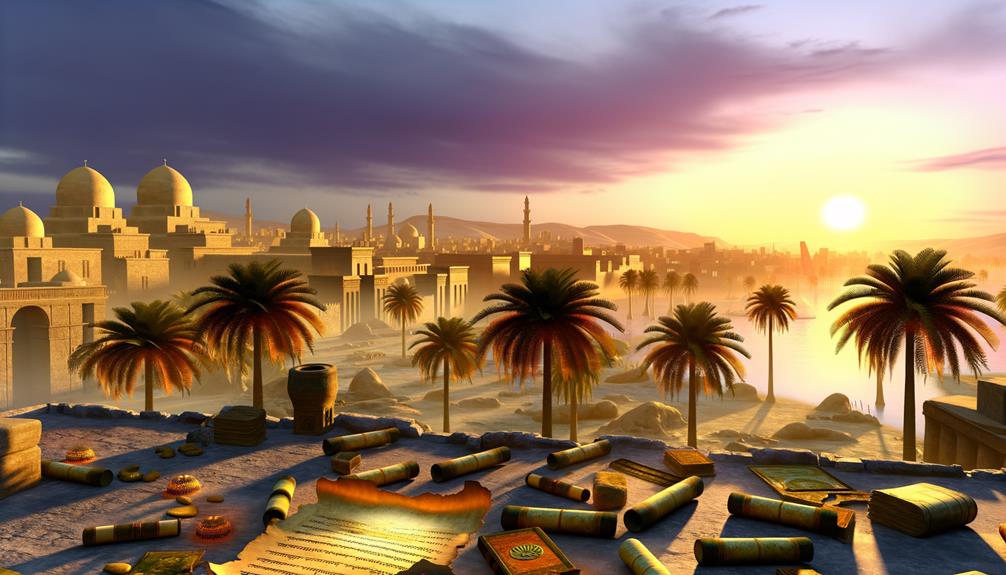
Cairo Meaning in the Bible: Historical and Spiritual Relevance
| Aspect | Explanation |
|---|---|
| Name Origin | Cairo derives from Arabic “Al-Qāhirah,” meaning “The Victorious” |
| Biblical Mention | Not directly mentioned; located in Egypt, which is prominent in the Bible |
| Historical Relevance | Near ancient biblical sites; Egypt symbolizes both refuge and bondage |
| Spiritual Interpretation | Represents power, worldliness, or transformation depending on context |
| Associated Events | Exodus, life of Moses, and the Holy Family’s flight into Egypt |
Biblical Geography and Cairo

Although Cairo is a prominent modern city, its geographical and historical significance in the context of biblical narratives necessitates a nuanced examination of its ancient counterparts and their roles in the biblical world.
Located near the ancient city of Memphis, Cairo’s region was a significant area in ancient Egypt, often referenced indirectly in biblical texts.
Memphis, once a capital of Egypt, is mentioned in the Book of Isaiah and the Book of Jeremiah as a center of idolatry and pagan worship.
Additionally, the nearby land of Goshen, where the Israelites resided during their Egyptian sojourn, lies within the same geographical vicinity.
Understanding Cairo’s antecedents provides critical insight into the historical and theological landscape that shaped biblical events and narratives.
Egypt in Biblical Times
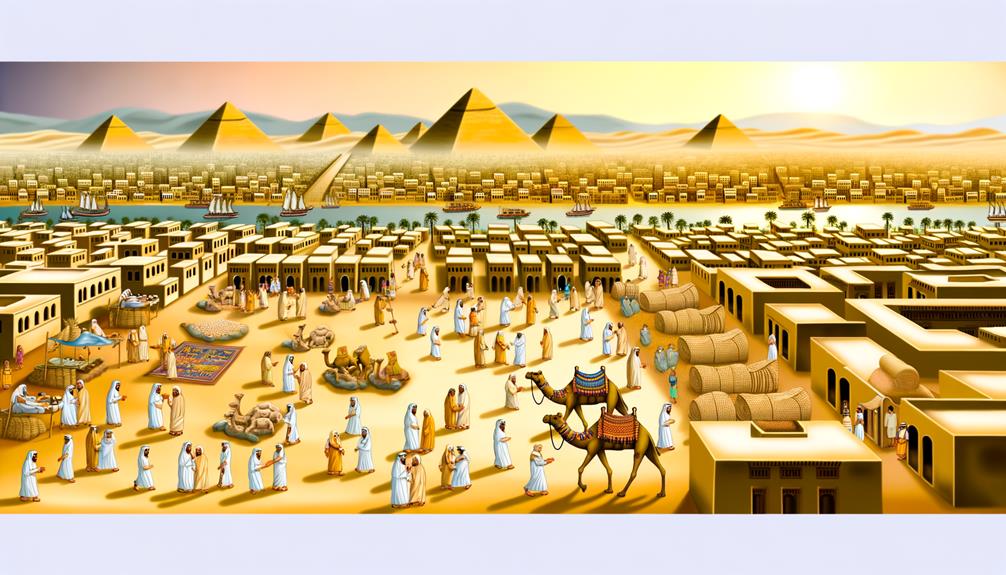
Egypt in biblical times was a land of profound significance, serving as both a place of refuge and a symbol of oppression in the narratives of the Old and New Scriptures.
In the Old Testament, Egypt is depicted as the land where Joseph rose to power and where Jacob’s family found sanctuary during famine (Genesis 41-47). Conversely, it is also the setting of the Israelites’ enslavement and their subsequent exodus under Moses’ leadership (Exodus 1-14).
In the New Testament, Egypt provided refuge for the Holy Family as they fled King Herod’s decree (Matthew 2:13-15).
Therefore, Egypt’s dual role highlights its complex theological and historical importance within biblical literature, embodying both divine provision and human suffering.
Historical Cairo and Exodus
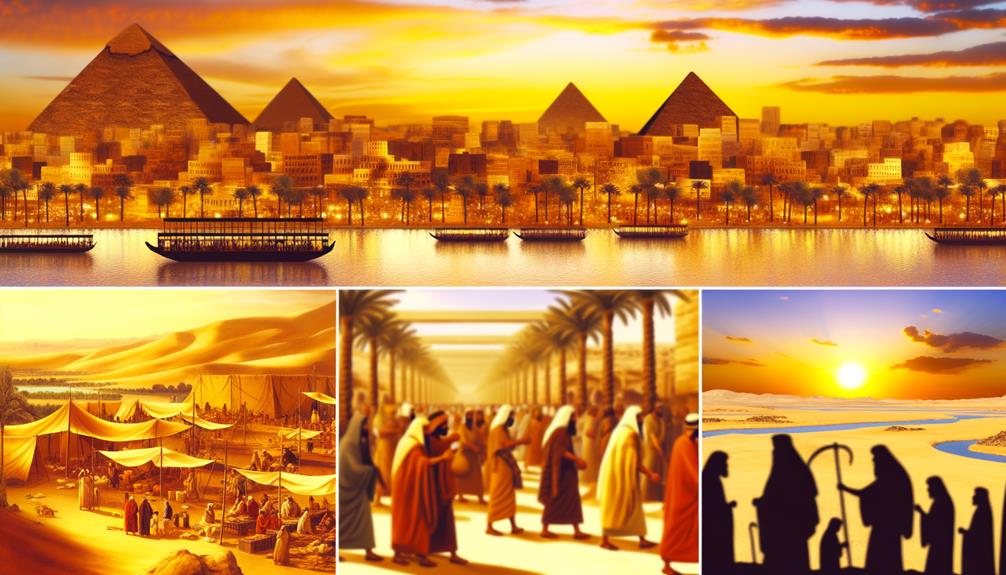
The historical significance of Cairo in the context of the Exodus narrative cannot be overstated, as it reflects the profound influence of ancient Egyptian civilization on biblical events.
The journey of the Israelites, often associated with their departure from Egypt, underscores a pivotal moment where the cultural and religious milieu of ancient Egypt intersects with the formative experiences of the Hebrew people.
Understanding these connections enriches our comprehension of how the Exodus narrative intertwines with Egypt’s historical landscape.
Ancient Egyptian Influence
Ancient Egyptian civilization, with its rich cultural and religious heritage, profoundly influenced the historical development and biblical narratives associated with Cairo and the Exodus.
The grandeur of Egypt, epitomized through its monumental architecture, governance, and religious practices, provided a backdrop against which biblical events, such as the sojourn of the Israelites and their subsequent Exodus, unfolded.
The integration of Egyptian motifs and symbols in biblical texts underscores the deep cultural interconnections.
| Aspect | Influence on Biblical Narratives |
|---|---|
| Architecture | Pyramids, Temples, and Monoliths |
| Governance | Pharaoh’s Rule and Bureaucracy |
| Religion | Polytheism and Religious Rites |
This profound interplay shaped the collective memory and theological constructs within the Bible, illustrating a complex interweaving of historical and spiritual dimensions.
Biblical Journey Connections
Central to the narrative of the Exodus, Cairo’s historical landscapes serve as a tribute to the enduring legacy of the Israelites’ journey from bondage to liberation.
While modern Cairo was not established until the 10th century AD, its vicinity to ancient Memphis and the Nile Delta places it near pivotal Exodus events. Egyptian records and Biblical texts interlace to depict a land marked by divine intervention and human resilience.
Scholars identify the region as a corridor of migration and conflict, where Moses and the Israelites purportedly traversed en route to the Promised Land. Theologically, it symbolizes God’s deliverance and covenant faithfulness, embedding Cairo within the broader tapestry of sacred history and collective memory.
Cairo’s Ancient Religious Sites
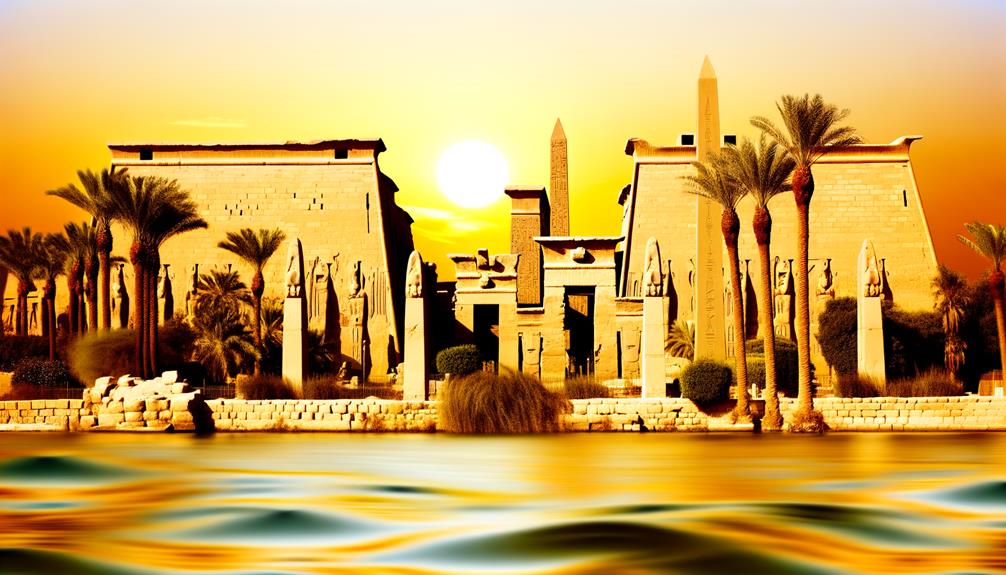
Nestled within the historic landscape of Cairo, several ancient religious sites offer profound insights into the spiritual heritage that has shaped the region over millennia. The city, a crossroads of civilizations, hosts monuments like the Babylon Fortress, a Roman-era structure that later became the site of key Christian churches, including the Hanging Church.
Additionally, the Ben Ezra Synagogue, believed to be the location where baby Moses was found, reflects Cairo’s deep Judaic roots. These sites not only underscore the city’s multidimensional religious history but also provide a palpable connection to the scriptural narratives that resonate through Judeo-Christian traditions.
For modern visitors and scholars alike, Cairo’s ancient religious landmarks serve as enduring representations of its rich, interwoven spiritual legacy.
Pharaohs and Biblical Stories
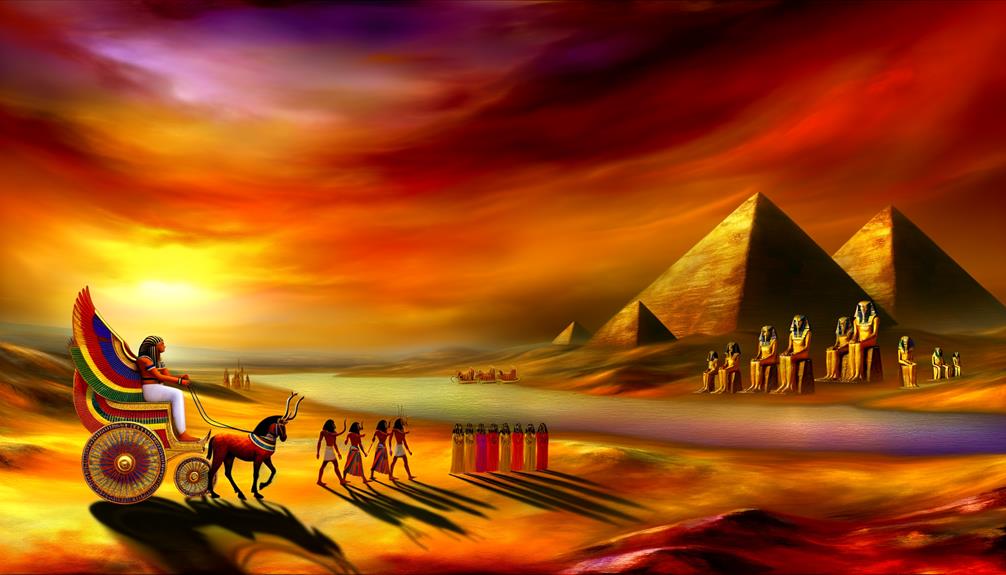
The narratives of the Pharaohs in the Bible provide a fascinating intersection of historical events and theological significance, particularly as they relate to the stories of Moses and the Exodus.
These accounts highlight the dynamic between divine power and earthly authority. The following aspects are critical to understanding the role of Pharaohs in these Biblical stories:
- Pharaoh’s Hardness of Heart: This theme underscores the resistance to divine commands, leading to the plagues of Egypt.
- The Plagues: Demonstrations of Yahweh’s supremacy over Egyptian gods and natural forces.
- The Exodus: The departure of the Israelites from Egypt, a pivotal moment of liberation.
- Pharaoh’s Downfall: The Red Sea incident symbolizing divine justice and deliverance for the Israelites.
These elements illustrate the profound theological messages woven into historical narratives.
Symbolism of Egypt in the Bible

In the biblical narrative, Egypt holds a multifaceted symbolism, representing both a place of bondage and a sanctuary.
Israel’s captivity in Egypt, as recounted in the Book of Exodus, depicts it as a land of oppression and divine deliverance.
Conversely, Egypt also serves as a refuge, as seen when the Holy Family sought safety from King Herod, highlighting its complex spiritual roles within scriptural contexts.
Israel’s Captivity in Egypt
Though often perceived as a place of refuge, Egypt in the biblical narrative symbolizes a land of bondage and oppression, epitomized by Israel’s prolonged captivity. The story of Israel’s enslavement in Egypt is a cornerstone of biblical history and theology, reflecting the trials and tribulations of God’s chosen people.
Key elements of this narrative include:
- Joseph’s Rise and Family’s Arrival: Initially a place of salvation during famine, Egypt later became a site of subjugation.
- Pharaoh’s Oppression: A new Pharaoh enslaved the Israelites, fearing their growing population.
- Moses’ Leadership: God appointed Moses to lead Israel out of bondage.
- The Exodus: The dramatic departure from Egypt symbolizes liberation and divine intervention.
This multifaceted symbolism continues to impact theological interpretations today.
Egypt as a Refuge
Egypt has often served as a place of refuge in the biblical narrative, providing temporary sanctuary during times of famine, danger, and political turmoil.
For instance, Abraham sought asylum in Egypt during a severe famine (Genesis 12:10). Similarly, Jacob’s family found refuge there when famine struck Canaan, leading to Joseph’s rise in Egyptian society (Genesis 46:1-7).
Egypt’s role as a haven extends to the New Testament, where Joseph, Mary, and the infant Jesus fled to escape King Herod’s massacre (Matthew 2:13-15).
These instances underscore Egypt’s dual role as both a place of oppression and a sanctuary. This multifaceted portrayal highlights the complexity of Egypt’s symbolic significance in the biblical context, serving as a temporary refuge in times of dire need.
Egypt’s Spiritual Symbolism
Biblical narratives frequently imbue Egypt with profound spiritual symbolism, often representing a place of both secular power and spiritual testing. Egypt emerges as a pivotal landscape in the scriptures, symbolizing various dimensions of the human spiritual journey.
Significantly:
- Exodus and Liberation: Egypt is the land of bondage from which God delivers the Israelites, symbolizing liberation from sin and oppression.
- Wealth and Power: The grandeur of Egypt often signifies worldly wealth and power, contrasting with spiritual impoverishment.
- Idolatry: Egypt’s pantheon of gods underscores a stark contrast to monotheistic worship, symbolizing spiritual deviation and false worship.
- Refuge and Sustenance: It also serves as a place of temporary refuge, as seen with Abraham and Joseph, symbolizing God’s provision in times of hardship.
This multifaceted symbolism underscores Egypt’s complex role in biblical theology.
Cairo’s Influence on Early Christianity

As a significant urban center in antiquity, Cairo played a pivotal role in shaping the theological and cultural landscape of early Christianity. Its strategic location facilitated the spread of Christian doctrines and provided a refuge for early Christians fleeing persecution. The city’s vibrant intellectual climate fostered theological debates and the development of early Christian thought.
| Aspect | Influence | Impact |
|---|---|---|
| Geographical Location | Migration and Refuge | Safe haven for persecuted Christians |
| Intellectual Climate | Theological Debates | Development of Christian doctrines |
| Cultural Exchange | Interaction with Scholars | Enriched Christian theological discourse |
Cairo’s rich cultural tapestry and its role as a crossroads of ideas greatly contributed to the foundational periods of Christian theology, making it an indispensable part of early Christian history.
Modern Cairo and Biblical Legacy

In contemporary times, Cairo continues to embody a profound biblical legacy, serving as a living witness to its historical and theological significance. The city’s modern landscape is infused with remnants of its biblical past, drawing connections between ancient scriptures and present-day experiences.
Significantly, Cairo offers:
- Religious Sites: Churches like St. Sergius and Bacchus, believed to be a refuge for the Holy Family.
- Historical Artifacts: Museums housing artifacts from the Pharaonic period mentioned in biblical accounts.
- Cultural Continuity: Traditions and practices that reflect ancient biblical customs.
- Scholarly Research: Institutions dedicated to the study of biblical history and archaeology.
These elements collectively reinforce Cairo’s enduring role as a bridge between the biblical era and the contemporary world.
Conclusion
The legacy of Cairo intertwines with biblical narratives, juxtaposing ancient Egypt’s grandeur with the Israelites’ trials.
While Egypt’s pharaohs symbolize oppression, its rich religious heritage offers a backdrop to pivotal biblical events.
As a cradle of early Christianity, Cairo’s historical and theological significance endures, bridging past and present.
Consequently, Cairo emerges not just as a geographical entity but as a profound symbol within the biblical canon and contemporary faith discourse, reflecting a complex tapestry of history and spirituality.






